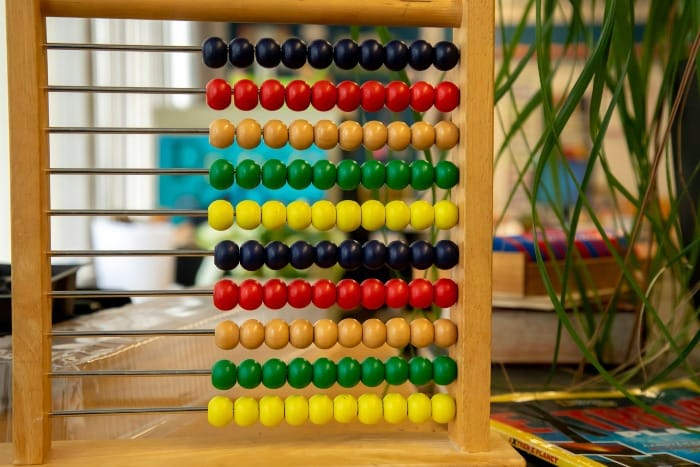Expressing Large Numbers In Tagalog
Learn how to express large numbers in Tagalog with this easy-to-follow tutorial. Beginner-friendly but perfect for advanced speaker, this guide includes examples and practical usage in conversations. Master counting in Tagalog today!

This is part 3 of the special series that I have prepared for winter season. The lessons have nothing to do about winter but while the nights are long and it is cold outside I have a bunch of indoor projects. One of them is updating my curriculum while occasionally pestering our princess cat, Nori. 😀

In the past couple of articles, I was talking about Tagalog Numbers. Specifically, I taught you how to say the single digits, the two digits, the tens, and the thousands. Today let us explore the wonderland of Large Numbers in Tagalog. When I mean "large", those are numbers greater than 'isáng daán' (100).
If you feel like this lesson is too basic for you and you are looking for Intermediate Tagalog lessons you may consider upgrading your membership for a few bucks per month. Tapos puwede kang tumalón sa pahinang iyón para mas matutuhan mo pa ang mga hiwagà ng ating Mga Pandiwà (Then you may jump over there so you learn further more of the mysteries of our Verbs).
On the other hand, if you are new in Tagalog I would give you five stars if you are able to count from one to one hundred in Tagalog. If you are still just counting from one to twenty please exert more effort by doing it repetitively. Push yourself to the limit, return to our previous Tagalog Tutorial and beat that old self of yours 'pagkatapos ng anim na minuto' (after 6 minutes).
I agree it is really hard to say the numbers in Tagalog, unfortunately. 😢 Pero kaya mo 'yan (but you've got this). With the right mentor you will say it right. Contact me if you need one.
Essential Questions
- How are 3-digit numbers expressed in Tagalog?
- How are 4-digit numbers expressed in Tagalog?
- How are 5-digit numbers expressed in Tagalog?
- How are 6-digit numbers expressed in Tagalog?
- How to count iteratively?
Let's start our todays practice with role playing. Follow the conversation below to see how numbers may be spoken in Tagalog.
Tagalog Conversation: A Restaurant Manager Speaking to a Customer
🗣️ 👂
Customer: Naghahanáp po akó ng venue para sa seminar na dadaluhán ng Samahán Ng Mga Mágsasaká sa baranggáy namin. May mauupahan po ba rito sa restaurant ninyó? (I'm looking for a venue for a seminar to be attended by the Association Of Farmers in our baranggay. Can we rent a space in your restaurant?)
Manager: Mayroón namán pò siguro. Iláng tao pò ba ang dadaló sa seminar? At iláng araw pò iyón? (You'll possibly be able to. How many persons will attend the seminar? And for how many days?)
Customer: Bale isáng daán at labindalawá pa lang ang nakalistá sa ngayón. Bakâ madagdagán pa itó bukas dahil puwede pang magparehistro bukas ang ibá. Pwede pò bang magpareserba ng para sa isáng daán at tatlumpúng tao? Tatlóng araw ang seminar. (We have about one hundred twelve persons that are registered by now. Maybe the number will increase tomorrow because others may still be able to sign up by then. Will you reserve us a space for one hundred thirty people? The seminar will run for three days.)
Manager: Isáng daán at tatlumpû... Hindi naman palá sila marami. Ipahahandâ ko pò ang ball room para sa inyó. Kahit pa mga tatlóng daán na tao ang dumatíng eh kasya silá doón. Dalawáng libo at walóng daáng piso ang upa ninyó kada araw. (Hundred thirty... Not too many. I shall have the ball room ready for you. Granting that three hundred people will come they may still be accommodated. You'll rent it for two thousand and eight pesos per day.)
Customer: Sigé po. Magbabayad kamí sa kabuuáng halagá
na walóng libo at apat na raáng piso. (Alright then. We'll pay you the total amount of eight thousand and four hundred pesos.)
With the dialogue above, notice that:
tatló (3) is a single digit number;
isang daán at labindalawá (112) is a 3-digit number;
isáng daán at tatlumpú (130) is also a 3-digit number;
tatlóng daán (300) is another 3-digit number;
dalawáng libo at walóng daán (2,800) is a 4-digit number; and
walóng libo at apat na raán (8,400) is also a 4-digit number.
Take note also that saying larger numbers will most likely occur in buying and selling transactions but I would like to reiterate that they simply say them in English; for efficiency as many believe. I would write a separate post on how Filipinos speak numbers in English, with accent for sure. 🫣
As with the previous article, I exist to persist to bring you pure Tagalog training on numbers.
Definition Of Terms
Before we proceed, I need to define a few terms which I will frequently use in this tutorial. These terms are not strictly prescribed for global use but only to provide a context to this discussion and might be used again in another related lessons.
- Lower Number: any number from 1 to 99 only.
- Large Number: any number from 100 to 999 only.
- Larger Number: any number greater than 999.
How To Express The 3-Digit Numbers In Tagalog
Here are more examples of the 3-digit numbers:
| Mga Bilang | Pinaiksî (Connected Speech) | Numbers |
|---|---|---|
| isáng daán at isá | 'sandaá't isá | 101 |
| isáng daán at sampû | 'sandaá't sampû | 110 |
| isáng daán at labíng-anim | 'sandaá't labíng-anim | 116 |
| isáng daán at pitumpû | 'sandaá't pitumpû | 170 |
| dalawáng daán at pitumpû't anim | dalwán daá't pitumpû't anim | 276 |
| siyám na raán at siyámnapú't siyám | syám na raá't syámnapú't syám | 999 |
Use the following format if you wish to say the hundreds in Tagalog:
where 'lower-number-word' is any number from 1 to 99 only.
Zero, in Tagalog is 'walâ', by the way. It just happened that the word walâ has no significance when expressing any number greater than zero. Therefore, you would like to start counting like this:
walâ, isá, dalawá, tatló, apat...
and then count in reverse order like this:
...apat, tatló, dalawá, isá, walâ.
How To Express The 4-Digit Numbers
Let us both agree: your job is to build your Tagalog brain muscles. Below are a few examples of 4-digit numbers. Read them aloud as you become tougher than ever:
| Mga Bilang | Pinaiksî (Connected Speech) | Numbers |
|---|---|---|
| isáng libo at isá | 'sanlibo't isá | 1,001 |
| isáng libo at sampû | 'sanlibo't sampû | 1,010 |
| isáng libo at labíng-anim | 'sanlibo't labíng-anim | 1,016 |
| isáng libo at pitumpû | 'sanlibo't pitumpû | 1,070 |
| dalawáng libo at pitumpû't anim | dalwán libo't pitumpû't anim | 2,076 |
| dalawáng libo, dalawáng daán at dalawampû | dalwán libo, dalwán daá't dalwampû | 2,220 |
| tatlóng libo, limáng daán, siyámnapû at waló | tatlun libo, limán daán, syámnapû't waló | 3,598 |
| walóng libo, isáng daán, siyámnapû at waló | walun libo, 'sandaán, syámnapû't waló | 8,198 |
Now let's find the pattern on how we want to say the numbers in Tagalog and since we are talking about 4-digit numbers, you are aware that the comma separates the hundreds from the thousands position. Notice that sometimes the Tagalog word 'at' ('and' in English) indicates the comma separator but not all the time.
You do not want to hear or say 'at' many times. So the question is when to say 'at' when saying a large number in Tagalog?
Format 1:
where 'lower-number-word' is any number from 1 to 99 only.
More examples (Ibá pang mga halímbawà):
- pitóng libo at labíntatló (7,013)
- apat na libo at limampú't apat (4,054)
Format 2:
where 'large-number-word' is any number from 100 to 999 only.
More examples (Ibá pang mga halímbawà):
- anim na libo, isáng daán at isá (6,101)
- anim na libo, anim na raán at tatlumpú't dalawá (6,632)
5-Digit Numbers
Are you still here? I'm glad...
Take more exercises but 5-digit numbers this time. Here you go:
| Mga Bilang | Numbers |
|---|---|
| labíng-isáng libo | 11,000 |
| labíndalawáng libo at isá | 12,001 |
| labínsiyám na libo at dalawampút tatló | 19,023 |
| dalawampûng libo | 20,000 |
| dalawampûng libo at limampú't dalawá | 25,052 |
| apatnapú't-anim na libo, tatlóng daán at walumpû | 46,380 |
| labímpitóng libo, siyám na raán at tatlumpú't anim | 17,936 |
The challenge to speaking large numbers right is to understand when to say the particle 'at' (in English it is 'and') or when to use 'apostrophe-t' ('t) instead of 'at' but that's beyond the scope of this series. Such topic will be delivered later under Beginners Tagalog Grammar.
Here are the patterns for speaking large numbers:
Format 3:
where 'lower-number-word' is any number from 1 to 99 only.
More examples (Ibá pang mga halímbawà):
- tatlumpú't pitóng libo at tatlumpú't isá (37,031)
- pitumpú't apat na libo at apatnapú't limá (74,045)
Format 4:
where 'large-number-word' is any number from 100 to 999 only.
More examples (Ibá pang mga halímbawà):
- animnapú't siyám na libo, isáng daán at dalawampû (69,120)
- animnapú't anim na libo, apat na raán at animnapú't dalawá (66,462)
How are you doing so far? I feel honored that you are still with me up to this point.
7-digit Numbers And Beyond
Million, in Tagalog, is "milyón" whereas billion is "bilyon". I believe that you are intuitive by now and have understood that expressing the numbers in your second language involves iterative process just like you do in English.
To express a seven-digit number, you will have any of these circumstances:
- Follow Format 1 presented above but replace the word 'libo' with 'milyon' and then adapt the techniques you learned when saying the 6-digit numbers.
- Follow Format 2 presented above but replace the word 'libo' with 'milyon' and then adapt the techniques you learned when saying the 6-digit numbers.
If you're given a certain n-digit number, simply group the digits into three's and then apply the universal Mathematics concept.
How fun!
But if you want to accelerate your fluency in Tagalog, consider signing up for my 1-on-1 Premium Classes. My teaching will be customized according to what you need but we will both agree on a certain set of goals to achieve at a certain period of time.
Hanggáng sa mulî (until next time),
Albine



Comments ()